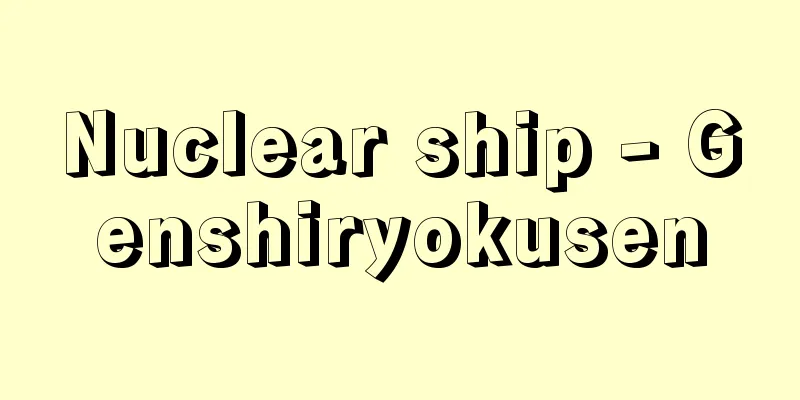Nuclear ship - Genshiryokusen

|
A ship that uses heat generated in a nuclear reactor to drive a turbine for propulsion. It is similar to a power-generating nuclear reactor in that the turbine is driven by steam generated in the reactor, but a compact reactor with little shielding is required to be installed on a ship. Because nuclear-powered ships use nuclear fuel, they can operate for long periods of time without refueling. The history of nuclear development is older than that of nuclear power generation, with military use preceding it. The nuclear submarine Nautilus was built in the United States in 1954, but even today there are overwhelmingly more military ships and very few ships for peaceful purposes. [Aoyagi Naganori] Nuclear ship reactorA nuclear reactor installed on a nuclear ship is called a marine reactor, and it has a long history of development. In the United States, a prototype submarine reactor (STW) was first built on land in 1953 at the National Reactor Testing Station in Idaho. The reactor type was a pressurized water reactor (PWR), which uses light water as a moderator and coolant and circulates the coolant under high pressure. It was later enlarged in the United States and became the prototype for power generation reactors. In order to make the core smaller, marine reactors use oxide fuel made of highly enriched or more enriched uranium than that used for power generation, coated with stainless steel or zircaloy. There are three types of structures: a separate type with a steam generator outside the pressure vessel, like power generation reactors, an integrated type with a steam generator inside a pressure vessel that has been improved to require smaller shielding, and a semi-integrated type with an intermediate structure. [Aoyagi Naganori] Nuclear ships of the worldNuclear ships have been built in countries around the world, but currently only Russian nuclear ships are in service for peaceful purposes. (1) Lenin and Russian nuclear ships The Lenin was the world's first nuclear ship, laid down in 1956 by the former Soviet Union as an icebreaker and completed in 1959. It was decommissioned in 1989 after 30 years and sailing approximately 650,000 nautical miles. There are currently seven Russian nuclear icebreakers in service, including the Arktika, as well as the nuclear cargo ship Sevmolput, which also has icebreaking capabilities. The icebreaker Ural has been under construction since 1994, but completion has been delayed due to a lack of funding. (2) Savannah Although the United States has a long history of building military ships, the first peaceful vessel was the cargo-passenger ship Savannah, which was completed in 1962. Over the course of eight years, the ship traveled approximately 450,000 nautical miles and visited 78 ports in 27 countries. After that, having accomplished its purpose, the fuel was removed from the reactor core and the ship was moored in the Port of Charleston. (3) Otto Hahn A nuclear ship of the former West Germany, laid down in 1963 as an experimental ship and completed in 1968. It was characterized by being equipped with an integral nuclear reactor, and after the experimental voyage it traveled about 250,000 nautical miles as an ore carrier using primary fuel. It continued to operate smoothly even after being loaded with a second improved reactor core in 1972, and after traveling about 600,000 nautical miles after completion, it was taken out of service in 1979 due to rising operating costs, had its fuel removed, and was moored in the Port of Hamburg. [Aoyagi Naganori] Japanese nuclear shipThe nuclear ship "Mutsu" was originally planned as an oceanographic research vessel by the Japan Atomic Ship Research and Development Agency, but due to lack of a construction company, the hull and reactor were built by another company as a special cargo ship. The hull was laid down in 1968, launched in 1969, and sailed to its home port of Ominato Port in Mutsu City, Aomori Prefecture, where it was equipped with reactor-related facilities and completed in 1972. In August 1974, radiation leaked during a power increase test on the high seas 800 km east of Cape Shiriyazaki in the open ocean, so repairs were made to the shielding and other parts at Sasebo Port in Nagasaki Prefecture. The radiation leak was caused by streaming, where radiation leaks between the reactor pressure vessel and the primary shielding, so additional shielding was installed. Much later than planned, in 1990, the ship's home port was moved to Sekinehama Port in Mutsu City, and the Japan Atomic Energy Research Institute, which had merged with the Atomic Energy Agency, converted it into an experimental vessel for power rise tests and sea trials, sailing a total of 12,900 nautical miles over 56 days. In 1991, the ship sailed for the first four experimental voyages, sailing a total of 34,700 nautical miles over 110 days, before being decommissioned in 1992. The initial plan by the JAEA to complete construction of the Mutsu by the end of 1971 was delayed by nearly 20 years, partly because the JAEA built a domestic marine reactor for which the JAEA had no technical experience, but more importantly because of flaws in the government and JAEA's development system, which meant that the hull and reactor were made independently by different companies and there was no system of overall responsibility. The radiation leak accident in 1974 brought into question the flaws in the reactor safety review system and nuclear development system, leading to the establishment of the Nuclear Safety Commission (Nuclear Regulation Authority since 2012). After being decommissioned, the Mutsu's hull was converted into a large oceanographic research vessel, and the reactor facilities removed from the hull are being decommissioned by the Mutsu facility of the Japan Atomic Energy Agency (established in October 2005 through the merger of the Japan Atomic Energy Research Institute and the Nuclear Cycle Development Institute). [Aoyagi Naganori] "Yoshio Ando, Nuclear Ship Mutsu - The Technology and History of the Mutsu" (1996, ERC Publishing) [Reference] | | |America's first nuclear-powered merchant ship. 1962 © Hayao Nogami "> Savannah (nuclear ship) Source: Shogakukan Encyclopedia Nipponica About Encyclopedia Nipponica Information | Legend |
|
原子炉で発生する熱を利用して駆動用タービンを動かし推進する船舶。原子炉で発生する蒸気でタービンを動かす点では発電用原子炉と同じであるが、船舶に搭載するため遮蔽(しゃへい)体の少ないコンパクトな炉を必要とする。原子力船は核燃料を使うので、長期間にわたり燃料補給をせずに運行できる。開発の歴史は原子力発電より古く、軍事利用が先行した。1954年に原子力潜水艦ノーチラス号がアメリカで建造されたが、現在でも軍用の艦船が圧倒的に多く、平和利用の船舶はほとんどない。 [青柳長紀] 原子力船の原子炉原子力船に搭載する原子炉を舶用(原子)炉というが、開発の歴史は古く、アメリカで1953年に潜水艦用原型炉(STW)が、まず陸上でアイダホの国立原子炉試験場に建設された。炉型は、減速材と冷却材に軽水を用い、高い圧力を加えて冷却材を循環させる加圧水型軽水炉(PWR)で、のちにアメリカで大型化され、発電用原子炉の原型となった。舶用炉は炉心を小さくするため、高濃縮または発電用より濃縮度の高いウランをステンレスかジルカロイで被覆した酸化物燃料を使う。構造上の種類としては、発電用と同じように圧力容器外に蒸気発生器をもつ分離型と、遮蔽体が小さくてすむように改良された圧力容器内に蒸気発生器をもつ一体型、およびその中間的構造をもつ半一体型の炉がある。 [青柳長紀] 世界の原子力船原子力船は、世界各国で建造されたが、最近では、平和利用としてはロシアの原子力船だけが就航中である。 (1)レーニン号とロシアの原子力船 レーニン号は、旧ソ連が砕氷船として1956年に起工、1959年に完成した世界最初の原子力船である。30年間、約65万海里の航行ののち1989年に退役した。ロシアの原子力砕氷船は、現在アルクチカ号など7隻が就航中であるが、その他砕氷能力をもった原子力貨物船セブモルプーチ号も就航している。1994年から砕氷船ウラル号が建造中であるが資金難のため完成が遅れている。 (2)サバンナ号 アメリカでは軍用の艦船の建造は古いが、平和利用の船としては1962年に貨客船サバンナ号が完成した。この船は8年間に約45万海里、27か国の78の港を訪問した。その後、目的を達成したとして、炉心から燃料を取り出し、チャールストン港に係船された。 (3)オットハーン号 実験船として1963年に起工、1968年に完成した旧西ドイツの原子力船。一体型原子炉を搭載したのが特徴で、実験航海後は鉱石運搬船として第一次燃料で約25万海里を航行した。1972年に第二次の改良炉心を装荷したのちも順調に運行し、完成後約60万海里の航行ののち、1979年、運行経費の上昇のため運行を停止、燃料を抜き取り、ハンブルク港に係留された。 [青柳長紀] 日本の原子力船原子力船「むつ」は、日本原子力船研究開発事業団により、当初海洋観測船として計画されたが、建造会社がないため、船体と原子炉を別会社が受け持ち特殊貨物船として建造された。船体は1968年に起工、1969年進水、定係港の青森県むつ市大湊(おおみなと)港に回航、そこで原子炉関連施設を搭載して1972年に完成した。1974年8月、外洋の尻屋崎(しりやざき)東方800キロメートルの公海上で出力上昇試験中放射線漏れをおこしたため、長崎県の佐世保(させぼ)港で遮蔽体などの改修工事を行った。放射線漏洩(ろうえい)の原因は、原子炉圧力容器と一次遮蔽体との間を放射線が漏れるストリーミングによりおこったもので、遮蔽体の追加工事をした。計画から大幅に遅れて、1990年(平成2)に定係港をむつ市関根浜港に移し、事業団を統合した日本原子力研究所が、用途を実験船にかえて出力上昇試験と海上試運転を実施し、合計56日間、約1万2900海里を航行した。その後、1991年に1次から4次の実験航海で110日、約3万4700海里を航行し、1992年に解役された。 当初「むつ」の建造を1971年末までに完了するという事業団の計画が、20年近く遅れた原因は、技術的に経験のない舶用炉を国産で建造したことにもよるが、それ以上に、船体と原子炉が別会社で独立につくられるなど総合的な責任体制がとられない政府や事業団の開発体制の欠陥のためである。1974年の放射線漏れ事故を機会に、原子炉の安全審査体制と原子力開発体制の欠陥が問題となり、原子力安全委員会(2012年より原子力規制委員会)ができた。 「むつ」の船体は、解役後大型海洋観測船へ改造され、船体から撤去した原子炉施設は、日本原子力研究開発機構(2005年10月日本原子力研究所と核燃料サイクル開発機構が統合して発足)むつ事業所が廃止措置を行っている。 [青柳長紀] 『安藤良夫著『原子力船むつ――「むつ」の技術と歴史』(1996・ERC出版)』 [参照項目] | | |アメリカ初の原子力商船。1962年©野上隼夫"> サバンナ号(原子力船) 出典 小学館 日本大百科全書(ニッポニカ)日本大百科全書(ニッポニカ)について 情報 | 凡例 |
<<: Nuclear battery - genshiryokudenchi
>>: Nuclear steelmaking - genshiryokusei-tetu
Recommend
Anchovy fishing
...Other than that, oil is produced on the northe...
Elmrant - Elmrant
…the name of a region in northern Poland that rou...
Ofuku (person's name) - Ofuku
...She was the wet nurse of Tokugawa Iemitsu. She...
sett
…Until the kilts we still wear today appeared in ...
Kanto region
...In the imperial decree of October 1183 (Juei 2...
Big-nosed serow - Ohana Kamoshika
…An even-toed ungulate mammal with a strange face...
Kakeshita - Kakeshita
… [Ikeda Takae] [Japanese underwear] In the broad...
Frankfurter Allgemeine
A world-famous German high-quality newspaper publi...
Natalus
…any mammalian bat in the genus Natalus that is i...
Stock investment trust - Kabushikitoushi
⇒Stock investment trust Source: About Shogakukan D...
Tsukiyo - Sakayaki
A type of hair styling method for men during the ...
Diapers
→Diapers Source : Heibonsha Encyclopedia About MyP...
Kyujanggak (English name)
An office for storing documents during the Joseon ...
Snefru
...For this reason, the Old Kingdom is also calle...
Kan'ami Kiyotsugu
→ Kan'ami Source: Shogakukan Encyclopedia Nip...



![Weser [river] - Weser](/upload/images/67caf99cc1807.webp)





